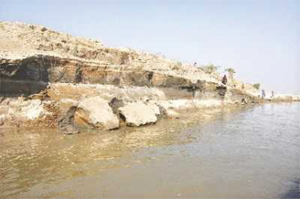
Every year many districts of Bangladesh witness flooding as the water levels in important rivers cross their danger marks at several points. It is almost an annual phenomenon in the country crisscrossed by scores of big and small rivers. In many parts of the country thousands of people living along their banks pass sleepless nights, haunted by the fear of losing their homes and hearths to riverbank erosion. This situation turns just worse in the northern and southern regions of the country. Thousands of villages come under the threat of being swept away by the swirling water in rivers, when in spate.
Villagers watch with trepidation the rivers approaching towards their homesteads. First the rivers erode their banks, farm lands and finally the thatched houses and everything else along the course. The villagers can do nothing but wait for the nightmarish day when the village will get wiped off the map.
The intensity of riverbank erosion is on the rise. At least five million people in 20 per cent of upazilas are at the risk of losing 1and and perhaps homesteads to riverbank erosion any time. Of them, at least 100,000 are forcibly displaced each year. An unknown but probably comparable number of people move voluntarily to other places.
Riverbank erosion is not new in this delta. What worries us most is not just the erosion, but its frequency and intensity. Riverbank erosion has got much worse along the Padma and its tributaries in the west, south and south-central regions of the country. Not only agricultural land and homesteads, but also several kilometres of roads and railways are also lost along with flood embankments each year. Some major cities and towns such as those in Chandpur, Rajshahi and Faridpur are also threatened by erosion.
Over the last three decades the Brahmaputra and the Padma devoured 180,000 hectares of agricultural land. From the 1970s to early 1990s the extent of mean annual erosion was about 3,300 hectares along both banks of the River Jamuna. During the last decade erosion along the river seemed to have declined slightly to range from 1,000 to 2,500 hectares per year. The mean annual erosion along the Padma was 1,400 hectares per year and the erosion increased to 2,200 hectares in the 1990s, according to the Water Development Board. Riverbank erosion at Sandwip and Kutubdia, apart from neighbouring Hatiya in Noakhali and other coastal belts, has been going on for years, with hundreds of people losing their homesteads every year. The affected people move inland without much government support. The affected people of the islands should be settled at designated places. They should be given cash and building materials so that they can set up new houses.
Local and regional factors on the environment front are exacerbating the erosion: these include climate change, deforestation in India and Nepal's Himalayas, the riverbeds silting up in the absence of adequate and appropriate river management and the growing population. As long as human interference with the course of a river is minimal, it has no problem changing its course. If habitations grow in the flood plains and flood control embankments are constructed, the rivers cannot change their course. They are forced to remain within the course and that results in erosion of their banks. There are other factors too aiding the process of erosion. The beds of rivers are getting progressively shallower due to siltation, further restricting their water carrying capacity. Construction of roads and dams also affects the release of flood water.
Riverbank erosion prevention measures are usually expensive and not compatible with the environment. Experts suggest bioengineering technologies like the use of bamboo. The Bangladesh Water Development Board (BWDB) must apply the bioengineering in flood protection because of its low cost and effectiveness.
Government efforts to check erosion of riverbanks have been marked by some short-term measures like stone patching, construction of spells, stacking up sand bags and so on. But there has been no systematic effort to address the problem in its entirety so far. Ironically, the government efforts to arrest floods through construction of embankments have added substantially to the problem of riverbank erosion in the country. This is so, because most of the rivers are in flow for less than half the year leading to an excessive flow or floods during the rainy season.
The authorities should make all-out efforts to improve the condition of rivers so that they maintain their usual flow throughout a greater part of the year. They have to go for a rethink on the policy of building embankments along the rivers and find alternatives to it. The concerned departments should ensure the cost-effective use of international technology and local knowledge in sustainable development of river bank protection.
© 2024 - All Rights with The Financial Express
